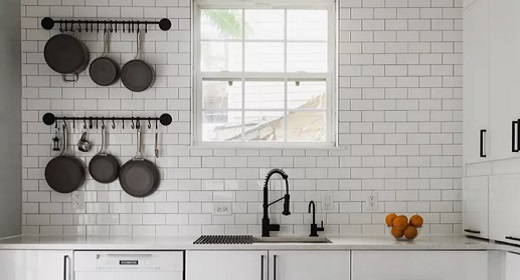by Melissa Breyer: For easier cooking, less waste, and a more serene environment, tackle the kitchen clutter hot spots…
It makes sense that the kitchen is a magnet for clutter. It is the heart of the home, and for many, it’s the room that sees the most use. It’s a place that is filled with collections of both heirlooms and tools, not to mention an ever-revolving assortment of perishable foods and staples.
It is also a room in which it can be hard to find the right balance between too much stuff and not enough. An overcluttered kitchen is hard to cook in, an over-minimal kitchen may be lacking the things one needs to prepare food.
Some people are comforted by clutter but for anyone looking for some visual serenity and an organized, less-cluttered space for easier cooking and reduced waste, consider addressing these hodgepodge hotspots.
Countertops
Has your toaster oven on the counter turned into a toaster oven, a blender, a fruit bowl, a few canisters, some knick-knacks, and a pile of mail? Are your cupboards so packed that condiments now live on the counter by your stove? If so, you may be depriving yourself of the glorious rarity that is a clear expanse of counter space on which to prepare food.
- The simple fix is to remember this: The counter is not a place for storage.
- And then part two: Everything should have a designated place to live.
If you are very short on space, you may not have much choice – but try to think of the counter as your work table, not a storage surface. And of course, there is room for flexibility; a coffee maker you use daily makes sense … but a stand mixer that you use once a month may be better housed elsewhere.
Refrigerator: Exterior
The marriage of magnets and the refrigerator is both a blessing and a curse. Being able to effortlessly post photos, notices, artwork, et cetera on such a prominent surface is lovely – but it can get out of hand. The eye gets accustomed to an ever-growing collage of bits and pieces, and before you know it, the whole thing is plastered with paper. One doesn’t have to be an unsentimental minimalist when it comes to the fridge display, but it’s worthwhile to assess every month or so and remove what’s dated; keep what’s essential, and rotate the special items. You can also use the “one in, one out” rule here.
Refrigerator: Top
Yes, the top of the fridge is a nice expanse of space – why not use it? A totally fine thing to do, but for a non-cluttered look, use this area strategically. If you’re going to stash stuff there, use it as a place for vases or attractive canisters rather than pantry overflow or bulky pots and pans,
Refrigerator: Interior
This one is important beyond the visual because a cluttered refrigerator is a fast track to food waste. When you can’t see or find food items, they all too often end up abandoned and spoiled. Here are some tips:
- Challenge yourself to eat most of the perishables on hand before stocking the fridge anew.
- Use glass containers for leftovers so that you remember what is what and actually eat them, rather than letting them turn into a science project.
- Store leftovers and older food in front; new and unopened food in the back.
- Get creative with small amounts of random ingredients; make soup or stock with vegetable parts, make salad dressing with bits of condiments left in jars, make new meals out of leftovers, et cetera.
Spice Rack
The normal scenario for dried herbs and spices is a confounding thing; many come in jars with quantities that might last a lifetime, yet the actual shelf life of many seasonings is a fleeting thing. They don’t go bad, per se, but they lose their potency. Andrea Feucht of the McCormick spice company gives these basic guidelines on shelf life:
Vanilla extract, salt: Infinite. (Other extracts will fade in 2-3 years.)
Whole spices (unground, such as peppercorns, whole allspice, caraway seeds, and more): 3-4 years.
Ground spices (such as cumin, ginger, paprika and chili powder): 2-4 years.
Ground and whole leafy herbs such as basil, oregano, rosemary, and most seasoning blends: 1-3 years.
So start by cleaning out your collection – any that have been hiding out for more than the recommended time can be used in one of the ways described in “What to Do With Old Herbs and Spices.” When you buy new jars, write the date of purchase on the back and try to be cognizant of using up those you’ve had for a while. Keep containers organized so that you don’t keep buying allspice when you already have two jars. Try organizing your spices in a top shallow drawer, or on a lazy Suzan in a cupboard so that you can see everything you have.
Utensil Drawer
Is your utensil drawer a hectic tangle of tools that you don’t exactly use all the time? This is a spot especially prone to the creeping in of clutter; often with the parade of specialty-use utensils to blame (hello, avocado slicer, mango peeler, and other novelty friends).
The first tip here is to resist the temptation to succumb to gimmicky utensils. After that, it’s a matter of paring them down to the essentials. If you cook a lot, you may have a lot of utensils that you use frequently – and others that you love enough to keep but don’t use that often. Use a prime drawer for the often-used items, and more remote real estate to store the less frequently used tools.
Also, when shopping for utensils, look for ones that can be used for a number of things. A box grater with different size holes, for example, can be used as a rough grater, fine grater, zester, and microplane.
Junk Drawer
Oh, the junk drawer. By its very nature, this glorious catch-all space attracts clutter, but an over-cluttered junk drawer is kind of a nightmare. Like, if you can’t open it because it’s so full? Or if looking for something in there requires digging and rummaging and makes it a more complicated mess?
Of course, the beauty of the junk drawer is that it provides a hiding spot for all the odds and ends, but rather than just using it as a dumping ground, a functioning junk drawer is a marvel. If you have a junk drawer, and it is one that takes on a life of its own, commit to organizing it on a regular basis, whether that’s every month, or once or twice a year.
Remove the drawer and put everything on the counter. Create a storage system within the drawer; depending on your junk style, this might be small jam jars or short cleaned cans for little things, drawer dividers for larger things, or a combination of both. Group like things together and find a spot for them, throw out any garbage that might have accumulated there, and return wayward items that live elsewhere to their proper storage spot. This may seem like a trivial pursuit, but if you are striving for an uncluttered kitchen, an organized junk drawer is strangely satisfying.
In conclusion, it’s good to remember that it’s not one size fits all when it comes to clutter. Some people may want to have more things out if that makes cooking easier for them; others may want a space that’s as sparse as a lab. But wherever you fall on the clutter spectrum, leaning toward less will give you more space to prepare food and less opportunity for waste.



















































